100th Anniversary Great Nave Tour at the Cathedral of St. John the Divine
Celebrate the 1925 construction of the stunning nave inside the world's largest Gothic cathedral!


Continuing Untapped New York’s exploration of the subway art installed by MTA’s Arts for Transit program, this week I went to explore along the J/Z lines.
In an unusual but effective move, five stations in a row–111th Street, 104th Street, Woodhaven Boulevard, 75th Street, and Cypress Hills–are all decorated with one work by Kathleen McCarthy, Five Points of Observation (1990-93). At each station a wire mesh face stares out from one side of the platform, looming over the neighborhood. Commuters can peer through it at their surroundings, while passersby catch a glimpse of dark shadows in the station.

Kathleen McCarthy, Five Points of Observation, 1990-93. 111th Street station.
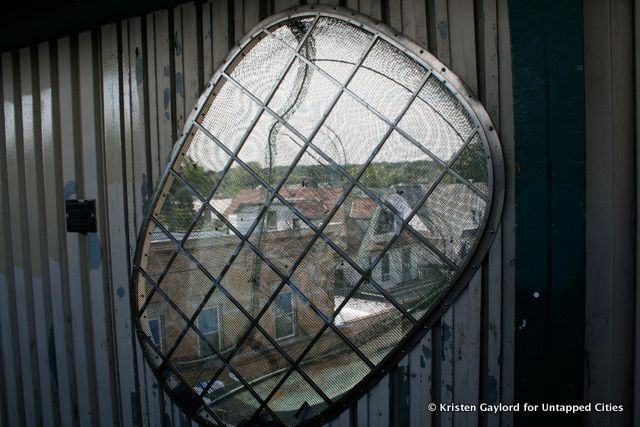
Kathleen McCarthy, Five Points of Observation, 1990-93. 111th Street station.
The works are unfortunately graffitied at every turn, and not always as visible as they should be from the street, but McCarthy’s faces are considered attempts at drawing attention to the momentary division between subway riders and pedestrians, and asking them to observe one another.

Kathleen McCarthy, Five Points of Observation, 1990-93. 104th Street station.

Kathleen McCarthy, Five Points of Observation, 1990-93. 104th Street station.
I’ve nicknamed the J/Z “the glass subway.” This medium adorns the platform windows or signs at many of the stations, trading unpredictability and innovation for the durability necessary on unprotected platforms. At Alabama Avenue are the untitled glass mosaics of Scott Redden (2007). Unusual in their subject matter–they depict trucks, farmhouses, a rooster, and other signifiers of rural life–they seem to want to provoke nostalgia or pastoral yearnings, juxtaposing their sense of rest with the immediate cityscape.

Scott Redden, Untitled, 2007.
While the imagery is simple I found myself caught by the beautiful and rich Chagall-esque colors of the glass. They provide contrast in another way, though: sporadically covered by plastic (probably for their own protection), the mosaics are often hard to discern through the scratches, graffiti, and heat blisters of their covers. The imagined idyll of the country is hardly visible through the realities of the city.
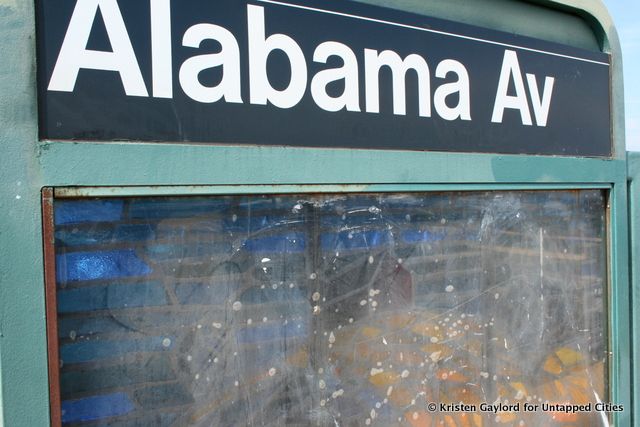
Scott Redden, Untitled, 2007.
I didn’t have to crane and snap my neck at too many stations before I found SOL-SAX’s SOL’SCRYPT (2008) at Halsey Street. The artist claims that these brightly colored square mosaics–set off to their best advantage by a setting sun behind them–fuse African and African-American culture in motifs inspired by design, art, and music.
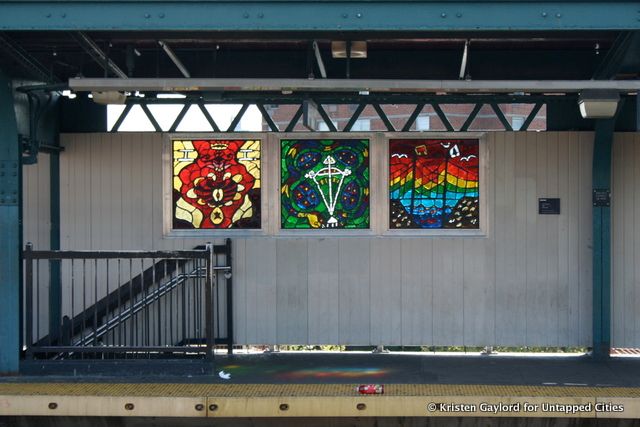
SOL-SAX, SOL’SCRYPT, 2008.
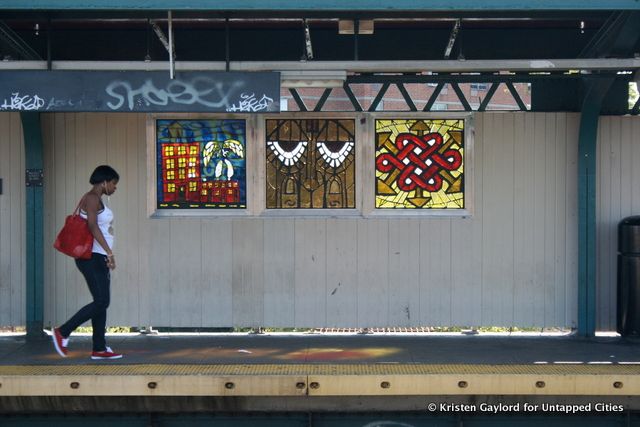
SOL-SAX, SOL’SCRYPT, 2008.
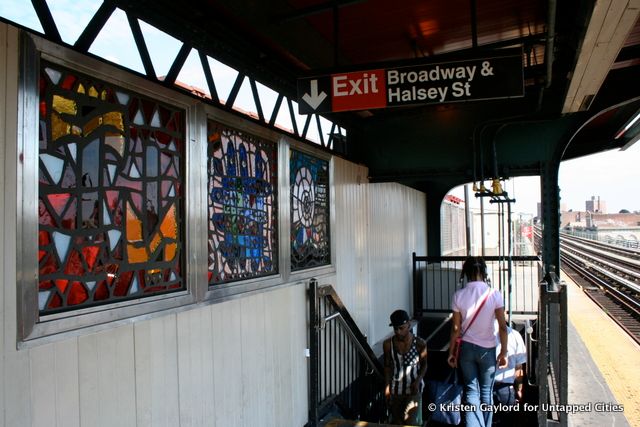
SOL-SAX, SOL’SCRYPT, 2008.
I was surprised to find, at Lorimer Street, “my” former subway station, that I had never seen Annette Davidek’s Roundlet Series (2002). When I got to the station I realized that it had been because I always entered at and waited by the east end of the platform, whereas Davidek’s flower-like designs are tucked away at the west. The intricate patterns are broken into colored pieces, fractured further by the glass’s rough-hewn edges.

Annette Davidek, Roundlet Series, 2002.
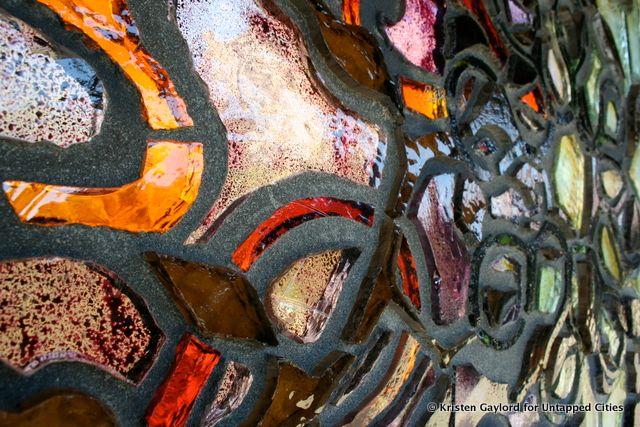
Annette Davidek, Roundlet Series, 2002.
At my first underground stop, Delancey Street – Essex Street, I encountered Ming Fay’s Shad Crossing (2004). Though the streets above are now more likely filled with designer shoes and $5 cups of coffee than baskets of fish, Fay calls back to New York’s natural and agrarian past with a lively mosaic of dazzling shad.

Ming Fay, Shad Crossing, 2004.
As I headed toward the end of the line, the subway art continued to turn towards New York’s past. At Canal Street, Bing Lee’s Empress Voyage 2.22.1794 (1998) references the 1794 expedition of the ship Empress of China, which returned to America loaded with goods from the Far East. Lee created a wall of stylized icons, looking toward both the 1794 expedition that signaled a new era of globalized trade and the current location of Canal Street as a center of Manhattan’s Chinatown.
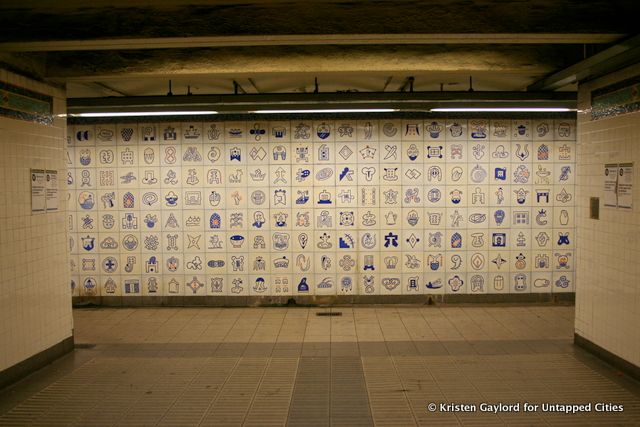
Bing Lee, Empress Voyage 2.22.1794, 1998.
If on my previous trips I noticed how quality art was spread throughout the four boroughs and that often the works seemed to be celebrating the subway’s accomplishments and centrality, my thoughts this time were a little less rosy. It was depressing to see so much great art vandalized, and the reality that the best pieces are saved for tourists and highly trafficked locations was evident on a line with few of these.
I set off to find my last chosen piece at Fulton Street / William Street, a set of terracotta murals created by Frederick Dana Marsh around 1913. I wandered around the station for about 20 minutes before determining that they all still must be in storage during the construction of Fulton Center. And, somehow, the failure of my mission cheered me up. The murals, treasured bits of New York craftwork and history, are being studied and cared for at the same time that a multi-billion dollar transportation hub is erected. That’s our city, always looking forward and backward, proud of its accomplishments yet ambitious for more.
Check out more from our Subway Art series here.
Get in touch with the author at @kaygegay
Subscribe to our newsletter